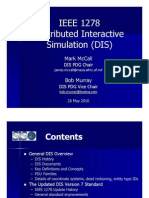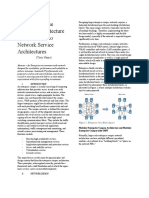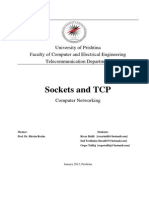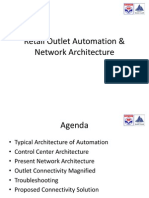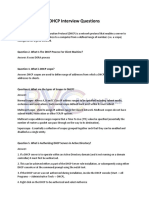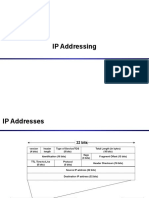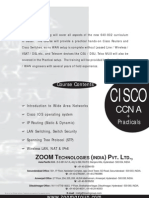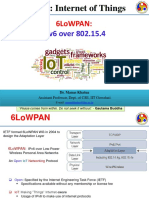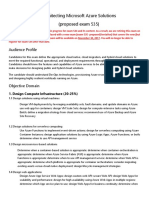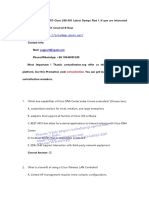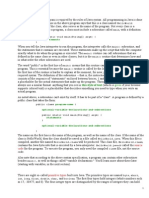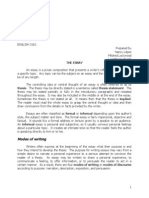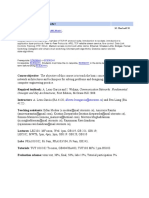Networking Fundamentals
Networking Fundamentals
Uploaded by
socmasterCopyright:
Available Formats
Networking Fundamentals
Networking Fundamentals
Uploaded by
socmasterCopyright
Available Formats
Share this document
Did you find this document useful?
Is this content inappropriate?
Copyright:
Available Formats
Networking Fundamentals
Networking Fundamentals
Uploaded by
socmasterCopyright:
Available Formats
1
Network
Fundamentals
1
Passport / Mike Meyers CompTIA Network+ Certification Passport / Michael Meyers / 178905-7 /
Chapter 1
ITINERARY
Objective 1.01 Overview of How Networks Work
Objective 1.02 The OSI Seven-Layer Model
Objective 1.03 The TCP/IP Model
NEWBIE SOME EXPERIENCE EXPERT
4 hours 2 hours 1 hour
ch01.ps
P:\010Comp\Passport\905-7\ch01.vp
Wednesday, March 14, 2012 5:13:41 PM
Color profile: Disabled
Composite Default screen
When you link computers together to share files and communicate and do all
the things we like to do, you create a network. Networks range in size from the
smallest and simplest networktwo computers connected togetherto the
largest and most complex network of allthe Internet.
This chapter begins with an overview of all the pieces that come together to
make a computer network, including the hardware needed to make the physical
connections. The chapter then dives into two network models techs use to dis-
cuss network components and functions.
Objective 1.01
Overviewof How
Networks Work
N
etworks come in many sizes and vary widely in the number of computers
attached to them. Some people connect two computers in their house so
that they can share files and play games togetherthe smallest network you can
have. Compare this to companies that have thousands of employees in dozens
of countries and need to network their computers together to get work done.
Network folks put most networks into one of two categories: LANs and WANs.
Youll find a few other groupings as well.
A local area network (LAN) covers a small area and contains a modest number
of computers (Figure 1.1). LANs are usually in a single building or group of
nearby buildings. Typical LANs include home and school networks.
2 MIKE MEYERS COMPTIA NETWORK+ CERTIFICATION PASSPORT
Passport / Mike Meyers CompTIA Network+ Certification Passport / Michael Meyers / 178905-7 /
Chapter 1
FIGURE 1.1 A local area network (LAN)
ch01.ps
P:\010Comp\Passport\905-7\ch01.vp
Wednesday, March 14, 2012 5:13:42 PM
Color profile: Disabled
Composite Default screen
A wide area network (WAN) covers a large area and can have a substantial
number of computers (Figure 1.2). Usually, a WANis composed of two or more
LANs connected together. All of the LANs in all of the schools in a city school
district, for example, link together to forma WAN. Computers ina WANusually
connect through some type of public network, such as a telephone system,
leased lines, or satellites. The largest WAN in existence is the Internet, which is a
worldwide network that connects millions of computers and networks.
An intranet, in contrast, is essentially a private TCP/IP network that is a
scaled-down version of the Internet for a very specific group of users. Just like
the Internet, an intranet will offer various network services, such as websites,
FTP access, Voice over IP, and so on. The key difference is that its private rather
than public.
Another similar term, extranet, is used to denote a private intranet that is also
made accessible to a select group of outsiders using the Internet.
CHAPTER 1 Network Fundamentals 3
Passport / Mike Meyers CompTIA Network+ Certification Passport / Michael Meyers / 178905-7 /
Chapter 1
FIGURE 1.2 A wide area network (WAN)
ch01.ps
P:\010Comp\Passport\905-7\ch01.vp
Wednesday, March 14, 2012 5:13:42 PM
Color profile: Disabled
Composite Default screen
Here are a few other xANs in use in various networks:
A campus area network (CAN) is a group of interconnected LANs
within a small geographical area, such as a school campus, university,
hospital, or military base.
A metropolitan area network (MAN) is a group of networks with a
sociopolitical boundary, such as a network of district authority offices
in a town or city. MANs can range in size from a few city blocks to
entire cities. Sites on a MAN are usually interconnected using
fiber-optic cable or some other high-speed digital circuit, and the MAN
itself may carry voice as well as data traffic.
A global area network (GAN) is a single network with connection
points spread around the world. GANs are used mostly by large
corporate organizations and consist of a series of networked, orbiting
satellites. Note the subtle difference between a WAN and a GAN. The
latter is a single network, not a number of interconnected networks.
Travel Advisory
The terms CAN and GAN dont exist as official standards, but their
use and definitions have become generally accepted over time.
A MAN is an official standard of the Institute of Electronics and
Electrical Engineers (IEEE) as the IEEE 802.6 standard.
Servers and Clients
People use two types of devices in networks these days: servers and clients. In a
nutshell, servers share thingssuch as files, folders, and printersand clients
request access to those shared things. Lets get one thing straight: Almost any
personal computer can act as a server or a client or both! Alot of it has to do with
how you set up the computer.
Computers running Windows, Macintosh, and the many varieties of Linux
make up the vast majority of clients. Youll also find other devices that are clients,
though, such as the following examples:
Game consoles, like the Xbox 360
Smartphones and tablets, such as the iPad
DVRs, like TiVo and other set-top boxes
Server computers come in all shapes and sizes, but they serveif youll pardon
the puna similar purpose. Servers manage network resources (like printers and
4 MIKE MEYERS COMPTIA NETWORK+ CERTIFICATION PASSPORT
Passport / Mike Meyers CompTIA Network+ Certification Passport / Michael Meyers / 178905-7 /
Chapter 1
ch01.ps
P:\010Comp\Passport\905-7\ch01.vp
Wednesday, March 14, 2012 5:13:42 PM
Color profile: Disabled
Composite Default screen
e-mailall the stuff that makes a network valuable), provide central storage of
files, and provide services for users (such as the printer server telling the printer to
print, or the e-mail server sending your e-mail). See Figure 1.3.
Client computers enable you to access the shared resources, programs, and
services on server machines (Figure 1.4). Most users access servers via clients,
although theres no law that says you cant access a server from another server
machine. The latter machine, in that case, would be acting as a client regardless
of the firepower of the box!
CHAPTER 1 Network Fundamentals 5
Passport / Mike Meyers CompTIA Network+ Certification Passport / Michael Meyers / 178905-7 /
Chapter 1
FIGURE 1.3 A server sharing network resources
FIGURE 1.4 A client accessing network resources
ch01.ps
P:\010Comp\Passport\905-7\ch01.vp
Wednesday, March 14, 2012 5:13:42 PM
Color profile: Disabled
Composite Default screen
Networks are traditionally classified into client/server and peer-to-peer
designations, depending on the role played by each computer in the network. In a
client/server network, one or more computer systems act as a server, while the
remaining computers are clients that access resources from the server. On some
home or small office networks, however, there may not be a separate server.
Instead, every computer on the network acts as both a client and a server. Such
networks are called peer-to-peer networks.
Exam Tip
The CompTIA Network+ exam uses the terms client/server topology and
peer-to-peer topology to describe these two network arrangements. A topology
more commonly refers to the way computers connect together rather
than the roles they play on a network, but be prepared for the
unusual use of the word on the exam. Chapter 3 covers the more
commonly described network topologies.
Every operating system (OS) today can operate as a client, a server, or both,
and many networks employ a mix. My network, for example, has a set of dedi-
cated servers and each employee has one, two, or more computers in his or her
office. Many of the office computers have shared folders, such as music or games,
so they function as both clients and servers. This nice mishmash of machine
roles creates a hybrid network.
Network Components
Whether you want to put together a LAN or connect a couple of LANs into a
WAN, you need connectivity between the PCs and a way to handle communica-
tion. Computers connect to a network in one of two ways:
Directly to a LANvia a cable fromthe computer to a LANport
Wirelessly to the LAN (this will be covered in Chapters 2 and 10)
A typical network client has a network adapter or network interface card
(NIC) that connects to a cable that connects to a central network box, called a
switch. Figure 1.5 shows a typical NIC.
Every NIC has a unique identifier called a media access control (MAC)
address. Ill go into more detail on these addresses in Chapter 4. For now, just
know that a MAC address acts like a name for a computer on a LAN.
6 MIKE MEYERS COMPTIA NETWORK+ CERTIFICATION PASSPORT
Passport / Mike Meyers CompTIA Network+ Certification Passport / Michael Meyers / 178905-7 /
Chapter 1
ch01.ps
P:\010Comp\Passport\905-7\ch01.vp
Wednesday, March 14, 2012 5:13:42 PM
Color profile: Disabled
Composite Default screen
To make this into a nicely configured network, add another network client.
Throw in a server. Dont add water, but turn on network sharing, and voil! You
have a network. Each machine attaches to a network cable that then connects at
the other end to the switch. Any device attached to a networkclient, server,
printer, or whatnotis called a node.
Ethernet
You might be wondering how you can tell what sort of cable to use for this net-
work and howto determine the type of switch required for a network. Network-
ing means communicating; the computers need to be able to speak the same
language and follow the same technology.
The Ethernet standard defines everything about modern network hardware.
Ethernet cables have standard connectors, for example, such as the RJ-45 con-
nectors shown in Figure 1.6. Ethernet defines electrical signaling as well. That
way, the sending NIC will break data down into little pieces and the receiving
NIC will know exactly how to put them back together.
If two machines do not have the same kind of networking technologya
common problemin the early days of computer networksthen they cant net-
work together. I wont bore youwitha list of all the networking technologies that
have had a brief moment of glory and market share in the past. Suffice it to say
that today, Ethernet is king of the LAN.
CHAPTER 1 Network Fundamentals 7
Passport / Mike Meyers CompTIA Network+ Certification Passport / Michael Meyers / 178905-7 /
Chapter 1
FIGURE 1.5 A network interface card
ch01.ps
P:\010Comp\Passport\905-7\ch01.vp
Wednesday, March 14, 2012 5:13:43 PM
Color profile: Disabled
Composite Default screen
Most modern Ethernet networks employ one of three technologies (and
sometimes all three), 10BaseT, 100BaseT, or 1000BaseT. As the numbers in the
names suggest, 10BaseT networks run at 10 Mbps, 100BaseT networkscalled
Fast Ethernetrun at 100 Mbps, and 1000BaseT networkscalled Gigabit
Ethernetrun at 1000 Mbps, or 1 Gbps.
Each Ethernet technology requires a specific kind of cabling that can handle
its top speed. 100BaseT networks use Category 5 (CAT 5) or better Ethernet ca-
bles (Figure 1.7), while Gigabit Ethernet runs on Category 6 (CAT 6) or better
Ethernet cables.
8 MIKE MEYERS COMPTIA NETWORK+ CERTIFICATION PASSPORT
Passport / Mike Meyers CompTIA Network+ Certification Passport / Michael Meyers / 178905-7 /
Chapter 1
FIGURE 1.6 RJ-45 connectors
FIGURE 1.7 Category 5e (CAT 5e) cable
ch01.ps
P:\010Comp\Passport\905-7\ch01.vp
Wednesday, March 14, 2012 5:13:43 PM
Color profile: Disabled
Composite Default screen
Hubs and Switches
Hubs and switches sit at the very center of networking, handling the tasks of re-
ceiving and sending packets of data to the connected computers. Each functions
quite differently when it receives an Ethernet frame.
Ahub repeats the frame down every network cable connected, hoping one of
the computers connected is the recipient machine, such as Johans laptop, for ex-
ample (Figure 1.8).
Aswitch, in contrast, learns the network address of every machine connected
to it, reads the recipient address on the frames, and sends themalong only on the
appropriate connection (Figure 1.9).
The radically more efficient switches now have completely replaced the ear-
lier hubs in the marketplace.
Software
Of course it takes both hardware and software to make network communication
work well. If Johans computer requests an MP3 file from Michaels computer,
Michaels operating system and other software take that MP3 file and break it
into small, individually numbered units called packets. The NIC then takes the
CHAPTER 1 Network Fundamentals 9
Passport / Mike Meyers CompTIA Network+ Certification Passport / Michael Meyers / 178905-7 /
Chapter 1
FIGURE 1.8 A hub repeating frames down every network cable
ch01.ps
P:\010Comp\Passport\905-7\ch01.vp
Wednesday, March 14, 2012 5:13:43 PM
Color profile: Disabled
Composite Default screen
packets and, following the Ethernet standards, wraps up those packets into net-
work frames that get sent out along the cable to the central network hub or
switch (Figure 1.10).
All the machines on the network must use the same languageor protocol
for any sharing to happen. Over the years, various protocols have been devel-
oped, and you had to choose the protocol that worked best with a specific type of
network or network needs. Today, that choice is easy because everybody uses
10 MIKE MEYERS COMPTIA NETWORK+ CERTIFICATION PASSPORT
Passport / Mike Meyers CompTIA Network+ Certification Passport / Michael Meyers / 178905-7 /
Chapter 1
FIGURE 1.9 A switch sending frames only to the recipient
FIGURE 1.10 Packets wrapped in frames sent along an Ethernet CAT 6 cable
ch01.ps
P:\010Comp\Passport\905-7\ch01.vp
Wednesday, March 14, 2012 5:13:43 PM
Color profile: Disabled
Composite Default screen
Transmission Control Protocol/Internet Protocol (TCP/IP), the language of the
Internet. Chapter 5 covers TCP/IP in depth, so I wont go into the details here.
Applications
Finally, you need network-aware applications to accomplish things like access-
ing a shared file over a network. A commonly used network application is the
web browser, such as Google Chrome, my personal favorite (Figure 1.11).
Connecting LANs
Enabling communication between two or more LANs requires several other
pieces. First, you need a physical connection through cabling or radio waves.
Second, you need special-purpose boxes to provide the intelligent direction so
CHAPTER 1 Network Fundamentals 11
Passport / Mike Meyers CompTIA Network+ Certification Passport / Michael Meyers / 178905-7 /
Chapter 1
FIGURE 1.11 Chrome web browser
ch01.ps
P:\010Comp\Passport\905-7\ch01.vp
Wednesday, March 14, 2012 5:13:44 PM
Color profile: Disabled
Composite Default screen
that data can properly floweither within a LAN(switches) or between the LANs
(routers). Finally, devices need an address that goes beyond the LANand applies
WAN-wide. Today, that address is an IP address, because everyone uses TCP/IP
to communicate. Chapter 5 covers IP addresses.
Travel Advisory
All nodes on a TCP/IP network have two addresses. The MAC
address is the physical address of a computer on a LAN. The IP
address enables communication across routers and thus between
LANs as well as within a LAN.
Objective 1.02
The OSI Seven-Layer
Model
T
he International Organization for Standardization (ISO) created a frame-
work into which the major network hardware and software components
and protocols couldbe placed to give every itema commonreference point. This
framework, called the Open Systems Interconnect (OSI) seven-layer model, pro-
vides a means of relating the components and their functions to each other and
a way of standardizing some of the components and protocols.
Travel Advisory
The letters used for the International Organization for
StandardizationISOdont map to the initials in English,
French, or Russian, the three official languages used by the body.
Rumors abound that the word is derived from a Greek word that
means equal, but those are just rumors.
The OSI model provides a critical common language that network hardware
and software engineers can use to communicate and ensure that their equip-
ment will function together. Each layer of the model represents a particular as-
pect of network function.
12 MIKE MEYERS COMPTIA NETWORK+ CERTIFICATION PASSPORT
Passport / Mike Meyers CompTIA Network+ Certification Passport / Michael Meyers / 178905-7 /
Chapter 1
ch01.ps
P:\010Comp\Passport\905-7\ch01.vp
Wednesday, March 14, 2012 5:13:44 PM
Color profile: Disabled
Composite Default screen
Exam Tip
The CompTIA Network+ exam expects you to know the layers by
name (especially layers 1 through 4), how they function in relation
to each other, and what they represent.
As well as helping to standardize the design elements of network compo-
nents, the OSI model helps describe the relationships between network proto-
cols. As youll see, more than one protocol or action is needed to get your data
onto a network.
The Layers and What They Represent
Lets run through the layers and an overview of their tasks and responsibilities.
Figure 1.12 summarizes the layers and their functions.
CHAPTER 1 Network Fundamentals 13
Passport / Mike Meyers CompTIA Network+ Certification Passport / Michael Meyers / 178905-7 /
Chapter 1
FIGURE 1.12 The seven-layer OSI model
ch01.ps
P:\010Comp\Passport\905-7\ch01.vp
Wednesday, March 14, 2012 5:13:44 PM
Color profile: Disabled
Composite Default screen
Layer 1: Physical Layer
Layer 1 of the OSI model, the Physical layer, defines the network standards
relating to the electrical signals that travel the network cables, the connectors,
and the media types (cables) themselves. The Physical layer also determines the
way that data is placed on the network media.
For the CompTIA Network+ exam, you need to know examples of compo-
nents that run at each layer of the OSI. Examples of network components that
are considered the Physical layer are cabling and hubs (Figure 1.13).
Layer 2: Data Link Layer
Layer 2, the Data Link layer, defines the rules for gathering and completing all
the elements that make up a data frame and putting the whole thing together so
that it can be passed to a Physical-layer device and on to the network. The exact
components of the frame will vary depending on the data-link protocol being
used, but would typically include the data being sent, an identifier for the send-
ing machine, an identifier for the receiving machine, and an error-correction
mechanism such as a frame check sequence (FCS).
14 MIKE MEYERS COMPTIA NETWORK+ CERTIFICATION PASSPORT
Passport / Mike Meyers CompTIA Network+ Certification Passport / Michael Meyers / 178905-7 /
Chapter 1
FIGURE 1.13 Layer 1 components
ch01-14.ps
P:\010Comp\Passport\905-7\ch01.vp
Friday, March 16, 2012 4:35:35 PM
Color profile: Disabled
Composite Default screen
The Data Link layer on the sending machine assembles outgoing frames and
calculates the FCS by applying a standard mathematical formula to the contents
of the frame. The receiving machine performs the same calculation for incom-
ing frames, enabling the receiving machine to verify the validity of the data by
comparing its locally generated FCS value with that sent in the frame. If the
values dont match, the frame is discarded and requested again.
The Data Link layer also determines how data is placed on the wire by using
an access method. The wired access method is carrier sense multiple access/
collision detection (CSMA/CD), used by all wired Ethernet networks.
The Data Link layer is divided into two sublayers:
Logical Link Control (LLC) The LLC is the component layer
responsible for error-correction and flow-control functions.
Media Access Control (MAC) The MAC is responsible for addressing
network devices by using the physical addressthats the MAC address
that is burned into the ROM chip of each network card. This physical
address is placed in the layer-2 header for the sending and receiving
system.
Exam Tip
For the CompTIA Network+ exam, know that layer 2 is divided into
two sublayers and is responsible for physical addressing. Any device,
such as a switch, that works with a physical address runs at
this layer.
Layer 3: Network Layer
Layer 3, the Network layer, is responsible for routing functions and logical
addressing. The Network layer addresses identify not only a system, but also
the network on which the system resides. The router uses this information to
determine how to send data to the destination network. The IP address in a
TCP/IP network is a layer-3 address; routers use this address to determine to
which network and node to send a packet.
Exam Tip
Examples of layer-3 components are the IP protocol and a router.
An IP address is considered a layer-3 address; a MAC address is
a layer-2 address.
CHAPTER 1 Network Fundamentals 15
Passport / Mike Meyers CompTIA Network+ Certification Passport / Michael Meyers / 178905-7 /
Chapter 1
ch01-14-16.ps
P:\010Comp\Passport\905-7\ch01.vp
Friday, March 16, 2012 1:56:15 PM
Color profile: Disabled
Composite Default screen
Layer 4: Transport Layer
If the data being sent is bigger than the packet size allowed by the lower-level
protocols, layer 4, the Transport layer, breaks the data into smaller, manageable
chunks that will fit inside two or more packets. Breaking up data into smaller
chunks is known as fragmentation.
The Transport layer is also responsible for confirming whether transmitted
packets have reached their destination intact and retransmitting them if they
havent. For incoming packets, the Transport layer reassembles the fragmented
data, ensuring that received packets are processed in the right order.
Exam Tip
Examples of layer-4 protocols are Transmission Control Protocol (TCP)
and User Data Protocol (UDP), which are part of the TCP/IP protocol
suite.
Layer 5: Session Layer
Layer 5, the Session layer, is responsible for the session setup. The Session layer
also manages and terminates the data connections (called sessions) betweenpro-
grams on networked devices. These sessions enable networked systems to ex-
change information.
Layer 6: Presentation Layer
Layer 6, the Presentation layer, is responsible for managing and translating the
informationinto anunderstandable format that the Applicationlayer canprocess
further. In fact, many Application-layer protocols function at the Presentation
layer too, taking datagrams and segments and turning theminto formats programs
can use.
Layer 7: Application Layer
Layer 7, the Application layer, represents the network-related program code and
functions running on a computer system that either initiate the request (on the
sending system) or service the request (on the receiving system).
Note that the Application layer does not refer to applications such as
Microsoft Outlook. Instead, it refers to the protocols on which those programs
rely. For example, Post Office Protocol 3 (POP3) and Simple Mail Transfer Pro-
tocol (SMTP) are important Application-layer protocols for e-mail, but many
different end-user applications use those protocols (such as Outlook and
Mozilla Thunderbird).
16 MIKE MEYERS COMPTIA NETWORK+ CERTIFICATION PASSPORT
Passport / Mike Meyers CompTIA Network+ Certification Passport / Michael Meyers / 178905-7 /
Chapter 1
ch01-14-16.ps
P:\010Comp\Passport\905-7\ch01.vp
Friday, March 16, 2012 1:56:16 PM
Color profile: Disabled
Composite Default screen
Using the Seven-Layer Model
The seven-layer model is only a theoretical representation of how networks
function. Although knowing it inside-out wont change your life, it should help
you pass the CompTIA Network+ exam. The conceptual use of the model
assumes that an event on one computer system (for example, a user pressing
ENTER on a login screen) creates some data that sets off a chain of events. The
data runs down through the layers on the sending machine and then leaves the
system, traveling across the network and then up through the layers on the re-
ceiving machine, until the data arrives intact at the Application layer and is pro-
cessed by the receiving system. Later chapters in this book point out where
certain key protocols and hardware fit into the model, and this can be useful
stuff to know for both the CompTIA Network+ exam and real life.
Objective 1.03
The TCP/IP Model
T
he OSI model was developed as a reaction to a world of many different pro-
tocols made by different manufacturers that needed to play together. ISO
created the OSI seven-layer model as the tool for manufacturers of networking
equipment to find common ground between multiple protocols, enabling them
to create standards for interoperability of networking software and hardware.
The adoption of TCP/IP as the sole protocol suite used in modern networks
has rendered the OSI seven-layer model somewhat obsolete at the layers specific
to TCP/IP. Many techs use a model specifically tailored to TCP/IP networks
called, appropriately, the TCP/IP model.
Local Lingo
Internet model A lot of techs and tech sites call the TCP/IP model
the Internet model.
The TCP/IP model consists of four layers:
Link/Network Interface
Internet
Transport
Application
CHAPTER 1 Network Fundamentals 17
Passport / Mike Meyers CompTIA Network+ Certification Passport / Michael Meyers / 178905-7 /
Chapter 1
ch01.ps
P:\010Comp\Passport\905-7\ch01.vp
Wednesday, March 14, 2012 5:13:45 PM
Color profile: Disabled
Composite Default screen
Its important to appreciate that the TCP/IP model doesnt have a standards
body to define the layers. Because of this, there are a surprising number of varia-
tions on the TCP/IP model. Some even have it as five layers rather than four!
A great example of this lack of standardization is the Link layer. Without a
standardizing body, we cant even agree on the name. While Link layer is ex-
tremely common, the termNetwork Interface layeris equally popular. Agood
tech knows both of these terms and understands that they are interchangeable.
Notice also that, unlike the OSI model, the TCP/IP model does not identify each
layer with a number.
CompTIA has chosen one popular version of the TCP/IP model for the
CompTIA Network+ competencies and exam. Thats the version youll learn
right here. Its concise, having only four layers, and many important companies,
like Cisco and Microsoft, use it, although with a few variations in names as just
described. The TCP/IP model gives each protocol in the TCP/IP protocol suite a
clear home in one of the four layers.
The clarity of the TCP/IP model shows the flaws in the OSI model. The OSI
model couldnt perfectly describe all the TCP/IP protocols. The TCP/IP model
fixes this ambiguity, at least for TCP/IP.
The Link Layer
The TCP/IPmodel lumps together the OSI models layer 1 and layer 2 into a sin-
gle layer called the Link layer (or Network Interface layer).
A nice way to separate layers in the TCP/IP model is to think about packets
and frames. Any part of the network that deals with complete frames is in the
Link layer. The moment the frame information is stripped away from an IP
packet, we move out of the Link layer and into the Internet layer.
Travel Advisory
At the Link layer, just about every network tech reverts back to the OSI model for
troubleshooting. Its important to distinguish between problems
happening at the Physical layer, with cabling, for example, and
problems that reflect the Data Link layer, with switches and MAC
addresses. Thats why accomplished techs know both models!
The Internet Layer
The Internet layer should really be called the IP packet layer. Any device or
protocol that deals with pure IP packetsgetting an IP packet to its
18 MIKE MEYERS COMPTIA NETWORK+ CERTIFICATION PASSPORT
Passport / Mike Meyers CompTIA Network+ Certification Passport / Michael Meyers / 178905-7 /
Chapter 1
ch01.ps
P:\010Comp\Passport\905-7\ch01.vp
Wednesday, March 14, 2012 5:13:45 PM
Color profile: Disabled
Composite Default screen
destinationsits in the Internet layer. IP addressing itself is also part of the
Internet layer, as are routers and the magic they perform to get IP packets to the
next router. IP packets are created at this layer.
The Transport Layer
The Transport layer combines features of the OSI Transport and Session layers
with a dash of Application layer just for flavor. While the TCP/IP model is cer-
tainly involved with the assembly and disassembly of data, it also defines other
functions, such as connection-oriented and connectionless communication.
Connection-oriented vs. Connectionless
Communication
Some protocols, like the popular Post Office Protocol (POP) used for sending
e-mail messages, require that the e-mail client and server verify that they have a
good connection before a message is sent (Figure 1.14). This makes sense because
you dont want your e-mail message to be a corrupted mess when it arrives.
Alternatively, a number of TCP/IP protocols simply send data without first
waiting to verify that the receiving system is ready (Figure 1.15). When using
Voice over IP (VoIP), for example, the call is made without verifying first
whether another device is there.
CHAPTER 1 Network Fundamentals 19
Passport / Mike Meyers CompTIA Network+ Certification Passport / Michael Meyers / 178905-7 /
Chapter 1
FIGURE 1.14 Connection between e-mail client and server
ch01.ps
P:\010Comp\Passport\905-7\ch01.vp
Wednesday, March 14, 2012 5:13:45 PM
Color profile: Disabled
Composite Default screen
The connection-oriented protocol is called Transmission Control Protocol
(TCP). The connectionless protocol is called User Datagram Protocol (UDP).
Travel Assistance
Chapter 5 covers TCP, UDP, and all sorts of other protocols in detail.
Everything you can do on the Internet, from web browsing to Skype phone
calls to playing World of Warcraft, is predetermined to be either connection-
oriented or connectionless.
Segments Within Packets and Datagrams Within
Packets
To see the Transport layer in action, strip away the IP addresses from an IP
packet. Whats left is a chunk of data in yet another container called a TCP
segment or a UDP datagram.
20 MIKE MEYERS COMPTIA NETWORK+ CERTIFICATION PASSPORT
Passport / Mike Meyers CompTIA Network+ Certification Passport / Michael Meyers / 178905-7 /
Chapter 1
FIGURE 1.15 Connectionless communication
ch01.ps
P:\010Comp\Passport\905-7\ch01.vp
Wednesday, March 14, 2012 5:13:46 PM
Color profile: Disabled
Composite Default screen
TCP segments have many fields that ensure the data gets to its destination in
good order. These fields have names such as Checksum, Flags, and Acknowl-
edgement. Chapter 5 goes into more detail on TCP segments, but for now, just
know that TCP segments have fields that ensure the connection-oriented com-
munication works properly. Figure 1.16 shows a typical (although simplified)
TCP segment.
Data comes from the Application-layer applications. The Transport layer
breaks that data into chunks, adding port numbers and sequence numbers, cre-
ating the TCP segment. The Transport layer then hands the TCP segment to the
Internet layer that, in turn, creates the IP packet, which encapsulates the
segment.
UDP also gets data from the Application-layer programs and adds port and
sequencing numbers to create a container called a UDP datagram. A UDP
datagram lacks most of the extra fields found in TCP segments, simply because
UDP doesnt care if the receiving computer gets its data. Figure 1.17 shows a
UDP datagram.
Just like with TCP segments, when the Transport layer hands the UDP
datagram to the Internet layer, it in turn creates the IP packet, which encapsu-
lates the datagram.
The Application Layer
The TCP/IP Application layer combines features of the top three layers of the
OSI model (Figure 1.18). Every application, especially connection-oriented ap-
plications, must know how to initiate, control, and disconnect from a remote
system. No single method exists for doing this. Each TCP/IP application uses its
own method.
CHAPTER 1 Network Fundamentals 21
Passport / Mike Meyers CompTIA Network+ Certification Passport / Michael Meyers / 178905-7 /
Chapter 1
FIGURE 1.16 TCP segment
FIGURE 1.17 UDP datagram
ch01-21.ps
P:\010Comp\Passport\905-7\ch01.vp
Monday, March 19, 2012 2:49:37 PM
Color profile: Disabled
Composite Default screen
TCP/IP uses a unique port-numbering system that gives each application
a unique number between 1 and 65,535. Some of these port numbers are very
well known. The protocol that makes webpages work, HTTP, uses port 80, for
example.
Although we can say that the OSI models Presentation layer fits inside the
TCP/IP models Application layer, no application requires any particular form
of presentation as seen in the OSI model. Standard formats are part and parcel
with TCP/IP protocols. For example, all e-mail messages use an extremely strict
format called Multipurpose Internet Mail Extension (MIME). All e-mail servers
and clients read MIME without exception.
In the OSI model, we describe the Application Programming Interface
(API)the smarts that make applications network awareas being part of the
Application layer. While this is still true for the TCP/IP model, all applications
designed for TCP/IP are, by definition, network aware. There is no such thing as
a TCP/IP word processor or a TCP/IP image editor that requires the added
ability to knowhowto talk to a networkall TCP/IPapplications can talk to the
network, as long as they are part of a network. Thats because they work directly
with the APIs at the Application layer to send and receive data.
22 MIKE MEYERS COMPTIA NETWORK+ CERTIFICATION PASSPORT
Passport / Mike Meyers CompTIA Network+ Certification Passport / Michael Meyers / 178905-7 /
Chapter 1
FIGURE 1.18 TCP/IP Application layer compared to OSI layers 57
ch01.ps
P:\010Comp\Passport\905-7\ch01.vp
Wednesday, March 14, 2012 5:13:46 PM
Color profile: Disabled
Composite Default screen
CHECKPOINT
Objective 1.01: Overview of How Networks Work The most obvious pieces
of network hardware are the computers on the network. These are divided
into client and server systems unless they are desktop systems that are shar-
ing resources, in which case they are known as peer-to-peer systems. Corpo-
rate networks generally use dedicated servers because they offer higher
performance, greater stability, and better security than peer-to-peer options.
Your network wont be complete without some mediasuch as copper wir-
ing, fiber optics, wireless, or infraredto interconnect your systems, as well
as a network interface card (NIC) to connect your system to the media.
Other devices on the networksuch as switches and routersenable you to
expand the system locally or to other sites.
Objective 1.02: The OSI Seven-Layer Model The OSI seven-layer model
describes how data flows from one networked system to anotherits a the-
oretical model into which many of the standards, components, and func-
tions of a network fit. The model promotes the use of recognized network
standards and helps ensure compatibility between network hardware and
software from different manufacturers.
Objective 1.03: The TCP/IP Model The TCP/IP model describes how data
flows from one networked system to another, specifically for TCP/IP net-
works. Every TCP/IP protocol and application fits into one of the four layers
in the model, making the TCP/IP model ideal for troubleshooting modern
networks.
REVIEW QUESTIONS
1. What name is given to a network in which computers act as both
clients and servers?
A. A multitasking network
B. A mainframe network
C. A peer-to-peer network
D. A LAN network
CHAPTER 1 Network Fundamentals 23
Passport / Mike Meyers CompTIA Network+ Certification Passport / Michael Meyers / 178905-7 /
Chapter 1
ch01.ps
P:\010Comp\Passport\905-7\ch01.vp
Wednesday, March 14, 2012 5:13:46 PM
Color profile: Disabled
Composite Default screen
2. What standard defines the hardware technology of modern LANs?
A. ARPANET
B. Ethernet
C. OSI
D. TCP/IP
3. Which device is being used if frames are repeated down every attached
Ethernet cable?
A. Modem
B. Switch
C. Frame
D. Hub
4. What device enables LANs to connect and direct packets to the correct
LAN?
A. Hub
B. Frame
C. Router
D. Switch
5. A protocol operating at which layer of the OSI model is responsible for
logical addressing and routing?
A. Transport
B. Network
C. Session
D. Application
6. A protocol operating at which layer of the OSI model handles the
formatting of data so upper or lower layers can work with them
further?
A. Application
B. Presentation
C. Session
D. Transport
7. Layer 3 is the __________ layer of the OSI model.
A. Session
B. Application
C. Data Link
D. Network
24 MIKE MEYERS COMPTIA NETWORK+ CERTIFICATION PASSPORT
Passport / Mike Meyers CompTIA Network+ Certification Passport / Michael Meyers / 178905-7 /
Chapter 1
ch01.ps
P:\010Comp\Passport\905-7\ch01.vp
Wednesday, March 14, 2012 5:13:46 PM
Color profile: Disabled
Composite Default screen
8. At which layer of the TCP/IP model are UDP datagrams created?
A. Link/Network Interface
B. Internet
C. Transport
D. Application
9. Which type of communication requires the client and server to
acknowledge the transmission?
A. ACK request
B. Connectionless
C. Connection-oriented
D. Session
10. At which layer of the TCP/IP model do cables fit?
A. Link/Network Interface
B. Internet
C. Transport
D. Application
REVIEW ANSWERS
1. C A network with computers acting as both clients and servers is a
peer-to-peer network.
2. B Ethernet is the standard.
3. D A hub repeats frames down every attached network cable.
4. C A router connects LANs and directs packets to the correct LAN.
5. B A protocol operating at the Network layer provides addressing and
routing functions.
6. B A protocol operating at the Presentation layer handles the
formatting of data (among other functions).
7. D Layer 3 of the OSI model is the Network layer.
8. C Data is divided into chunks at the Transport layer and then
bundled into UDP datagrams or TCP segments, depending on which
protocol is used.
9. C Connection-oriented communication requires the client and
server to acknowledge the transmission.
10. A Cabling is in the Link/Network Interface layer of the TCP/IP model.
CHAPTER 1 Network Fundamentals 25
Passport / Mike Meyers CompTIA Network+ Certification Passport / Michael Meyers / 178905-7 /
Chapter 1
ch01.ps
P:\010Comp\Passport\905-7\ch01.vp
Wednesday, March 14, 2012 5:13:46 PM
Color profile: Disabled
Composite Default screen
You might also like
- Hpat Ireland Additional Practice QuestionsDocument33 pagesHpat Ireland Additional Practice Questionssocmaster100% (2)
- TPNA SOHO Examination OutlineDocument5 pagesTPNA SOHO Examination OutlineMeraqui SingerNo ratings yet
- 200 Networking Interview Questions With AnswersDocument37 pages200 Networking Interview Questions With Answersazeem08179No ratings yet
- Lavelle Networks - SDWAN PDFDocument21 pagesLavelle Networks - SDWAN PDFKevin DsouzaNo ratings yet
- Cloud - Chapter 8Document33 pagesCloud - Chapter 8shree_74No ratings yet
- Express e User GuideDocument141 pagesExpress e User GuideSergio100% (1)
- L0Phtcrack: Made By:-Surabhi VarmaDocument21 pagesL0Phtcrack: Made By:-Surabhi VarmaSurabhi VarmaNo ratings yet
- Name Three Steps Which You Would Use To Troubleshoot FTP Server Related ProblemsDocument6 pagesName Three Steps Which You Would Use To Troubleshoot FTP Server Related ProblemsaknithyanathanNo ratings yet
- An Introduction To SD-WAN EbookDocument13 pagesAn Introduction To SD-WAN EbookKevin Dsouza100% (1)
- C1 Book SolutionDocument807 pagesC1 Book SolutionRupack Halder100% (3)
- DIS Overview V7info PDFDocument61 pagesDIS Overview V7info PDFforumid2697No ratings yet
- Chapter 1Document38 pagesChapter 1CharleneKronstedtNo ratings yet
- Manual Rádio SIAEDocument324 pagesManual Rádio SIAERicardi Martinelli MartinsNo ratings yet
- Large Enterprise Network Architecture Design 1Document4 pagesLarge Enterprise Network Architecture Design 1Abilashini jayakodyNo ratings yet
- Sockets and TCP PDFDocument29 pagesSockets and TCP PDFGzim DragushaNo ratings yet
- Multi Tenancy Issues in Cloud SecurityDocument7 pagesMulti Tenancy Issues in Cloud Securitydarshita singhNo ratings yet
- Module 1 - Implementing Advanced Network ServicesDocument66 pagesModule 1 - Implementing Advanced Network ServicesEricPattersonNo ratings yet
- SDLCDocument49 pagesSDLCChutiya InsaanNo ratings yet
- Network Monitoring and MeasurementDocument22 pagesNetwork Monitoring and MeasurementArdi SyahNo ratings yet
- IP Risk and Compliance ManagementDocument4 pagesIP Risk and Compliance Managementth3sorcererNo ratings yet
- Matter EnabledDocument7 pagesMatter Enabledsuraj kumarNo ratings yet
- 5 Reasons Why EIP DDI Is BetterDocument3 pages5 Reasons Why EIP DDI Is BetterSameer JadhavNo ratings yet
- Unit Nexus Interview Questions and Answers Guide.: Global GuidelineDocument13 pagesUnit Nexus Interview Questions and Answers Guide.: Global GuidelineVenkatesanNo ratings yet
- Cyber Security Lecture Notes 03Document23 pagesCyber Security Lecture Notes 03Sampath DarshanaNo ratings yet
- NERC Standardized Component Model ManualDocument19 pagesNERC Standardized Component Model ManualNagy AbedNo ratings yet
- Network Architecture ofDocument10 pagesNetwork Architecture ofManish SaunNo ratings yet
- DHCP Interview Questions PDFDocument4 pagesDHCP Interview Questions PDFJay SarkarNo ratings yet
- Gartner Market Guide DDI 25042014Document6 pagesGartner Market Guide DDI 25042014Mohamed Osama AbosreeNo ratings yet
- Cheat SheetDocument1 pageCheat SheetNheb Naares Nheb NaareesNo ratings yet
- Unit 3.2-IP AddressingDocument21 pagesUnit 3.2-IP AddressingYuvaraj TankalaNo ratings yet
- Glib Docs PDFDocument616 pagesGlib Docs PDFDo Thu ThuyNo ratings yet
- Zoom CcnaDocument2 pagesZoom CcnaNaresh KumarNo ratings yet
- GCP Fund Module 6 Applications in The CloudDocument26 pagesGCP Fund Module 6 Applications in The CloudAvinash R GowdaNo ratings yet
- Wide Enterprise NetworkingDocument8 pagesWide Enterprise NetworkingŠhő VØňNo ratings yet
- Radius - Quick Guide Aaa and Nas?Document7 pagesRadius - Quick Guide Aaa and Nas?samantaarindamNo ratings yet
- 127 1 Networking Interview Questions and AnswersDocument13 pages127 1 Networking Interview Questions and AnswersManoj KarthiNo ratings yet
- CCNA Questions and AnswersDocument14 pagesCCNA Questions and AnswersBinh TieuNo ratings yet
- Demo PPT - Introduction To AWSDocument9 pagesDemo PPT - Introduction To AWSD.R.Anitha Sofia Liz CSE STAFFNo ratings yet
- Portnox CORE PB v3 WebDocument2 pagesPortnox CORE PB v3 WebMilošKovačevićNo ratings yet
- S.O.L.I.D. Software Development, One Step at A TimeDocument36 pagesS.O.L.I.D. Software Development, One Step at A TimejunkyardNo ratings yet
- Application Aware Routing System (A2RS) For Software Defined NetworksDocument27 pagesApplication Aware Routing System (A2RS) For Software Defined Networksbakshi_gulamNo ratings yet
- 244 Thales Encryption Key ManagementDocument13 pages244 Thales Encryption Key ManagementAdam GirardoNo ratings yet
- Cs578: Internet of Things: Ipv6 Over 802.15.4Document45 pagesCs578: Internet of Things: Ipv6 Over 802.15.4shubhamNo ratings yet
- Red Hat System Administration I On RHEL 7 RH1241Document2 pagesRed Hat System Administration I On RHEL 7 RH1241RishabNo ratings yet
- Web Security For DevelopersDocument8 pagesWeb Security For DevelopersBobNo ratings yet
- Unit - 4-CloudDocument122 pagesUnit - 4-CloudsujayNo ratings yet
- DHCP Cheatsheet PDFDocument1 pageDHCP Cheatsheet PDFNayanendu MohantyNo ratings yet
- GCP Collated Version1Document22 pagesGCP Collated Version1Sivakumar Bala100% (1)
- Wireshark Analysis of Trace File-UtarDocument22 pagesWireshark Analysis of Trace File-UtarLam Chen RiangNo ratings yet
- Architecting Microsoft Azure SolutionsDocument5 pagesArchitecting Microsoft Azure SolutionsDeva KumarNo ratings yet
- Sample Network Engineering ResumeDocument3 pagesSample Network Engineering ResumeShahriar Azgar100% (2)
- Drew Tadgerson Networking Concepts & Apps Mini Cases - Chapter 11 & 12 MIS589 February 24, 2013 Shaun GrayDocument5 pagesDrew Tadgerson Networking Concepts & Apps Mini Cases - Chapter 11 & 12 MIS589 February 24, 2013 Shaun GrayeatspizzaNo ratings yet
- Study of Cloud Computing in HealthCare IDocument5 pagesStudy of Cloud Computing in HealthCare IDina TrisnawatiNo ratings yet
- Hadoop and Related ToolsDocument57 pagesHadoop and Related ToolsPrem PrasadNo ratings yet
- Csc4306 Net-Centric ComputingDocument5 pagesCsc4306 Net-Centric ComputingAli musa baffa100% (1)
- Ccna 2020 200-301Document13 pagesCcna 2020 200-301Kazi Didar Hossain ShohanNo ratings yet
- JNU ITpolicyDocument46 pagesJNU ITpolicyHari Hara SudhanNo ratings yet
- Ai IntroDocument33 pagesAi IntroNithishNo ratings yet
- Total Cost of Ownership (TCO) Calculator: Estimate The Cost Savings You Can Realize by Migrating Your Workloads To AzureDocument12 pagesTotal Cost of Ownership (TCO) Calculator: Estimate The Cost Savings You Can Realize by Migrating Your Workloads To Azureinfo.glcom5161No ratings yet
- About Us - Hackveda LimitedDocument2 pagesAbout Us - Hackveda Limited19BMA111 GOKULNo ratings yet
- SonaliA. NaviMumbai 8 YrsDocument5 pagesSonaliA. NaviMumbai 8 YrsAnuja AhireNo ratings yet
- Computer Hardware and Networking SyllabusDocument5 pagesComputer Hardware and Networking SyllabusRiyas FasilNo ratings yet
- Java ManualDocument38 pagesJava ManualsocmasterNo ratings yet
- Sample Letters of Recommendation: Appendix GDocument3 pagesSample Letters of Recommendation: Appendix GsocmasterNo ratings yet
- Pascal TutorialDocument172 pagesPascal TutorialsocmasterNo ratings yet
- The Essay HintsDocument7 pagesThe Essay HintssocmasterNo ratings yet
- Internet Security Features About The Internet: How Web Information Is Located On The InternetDocument11 pagesInternet Security Features About The Internet: How Web Information Is Located On The InternetsocmasterNo ratings yet
- Excel For Civil EngineeringDocument9 pagesExcel For Civil Engineeringsocmaster100% (2)
- 405 M.E. Computer Science and EngineeringDocument68 pages405 M.E. Computer Science and EngineeringThanuambikaNo ratings yet
- Flyer BlueLine Rev-05 enDocument8 pagesFlyer BlueLine Rev-05 enajaysapruNo ratings yet
- MS WmiDocument237 pagesMS WmiJay PrakashNo ratings yet
- Siw4 Esa Wireless WGDocument16 pagesSiw4 Esa Wireless WGnicolasNo ratings yet
- Using The LwIP Network StackDocument34 pagesUsing The LwIP Network StackJames DoolinNo ratings yet
- Ekiden - A Platform For Confidentiality-Preserving, Trustworthy, and Performant Smart Contract ExecutionDocument26 pagesEkiden - A Platform For Confidentiality-Preserving, Trustworthy, and Performant Smart Contract ExecutionJexiaNo ratings yet
- Delphi ProgrammingDocument18 pagesDelphi ProgrammingDamir OmanovićNo ratings yet
- Syllabus PDFDocument2 pagesSyllabus PDFJoey ZhouNo ratings yet
- Distributed Resource Allocation For DS-CDMA-Based Multimedia Ad Hoc Wireless LAN'sDocument21 pagesDistributed Resource Allocation For DS-CDMA-Based Multimedia Ad Hoc Wireless LAN'sfeku fekuNo ratings yet
- 6 ProgQP IDocument14 pages6 ProgQP IVijay SharmaNo ratings yet
- TI Low Power RF: Designers Guide To LPRFDocument64 pagesTI Low Power RF: Designers Guide To LPRFShafqat UllahNo ratings yet
- 5 ModbusDocument39 pages5 ModbusMahar Tri WahyudinNo ratings yet
- Building Automation and Control SystemsDocument10 pagesBuilding Automation and Control SystemsmuddogNo ratings yet
- ProtocolDocument20 pagesProtocoloctober_winterNo ratings yet
- Wcdma ChannelsDocument19 pagesWcdma ChannelsRitesh RanjanNo ratings yet
- Smart Phone: An Embedded System For Universal InteractionsDocument12 pagesSmart Phone: An Embedded System For Universal InteractionsraghueshNo ratings yet
- Sensus Network White PaperDocument18 pagesSensus Network White PaperSensus NetworkNo ratings yet
- Idoc AaeDocument3 pagesIdoc AaeDurga VenkateshNo ratings yet
- Acom EVO Manager 025-9642 PDFDocument83 pagesAcom EVO Manager 025-9642 PDFSohaib Omer SalihNo ratings yet
- (英文) HART数据链路层规范 SPEC 081 PDFDocument40 pages(英文) HART数据链路层规范 SPEC 081 PDFvirgil guimanNo ratings yet
- 99069r1P802 15 Bluetooth Architecture OverviewDocument29 pages99069r1P802 15 Bluetooth Architecture OverviewYogeeshHtNo ratings yet
- OpNET ModelingDocument12 pagesOpNET ModelingUmar FarooqNo ratings yet
- Ts 125321v100400p PDFDocument202 pagesTs 125321v100400p PDFeutraNo ratings yet
- TCP/IP Sockets in CDocument100 pagesTCP/IP Sockets in CMuhammad Abd Al-Galeil100% (3)
- SIEMENS Technical Paper 2Document18 pagesSIEMENS Technical Paper 2Saniya Shaikh100% (1)
- E560 SD Release 3Document110 pagesE560 SD Release 3Faiz MandeelNo ratings yet










